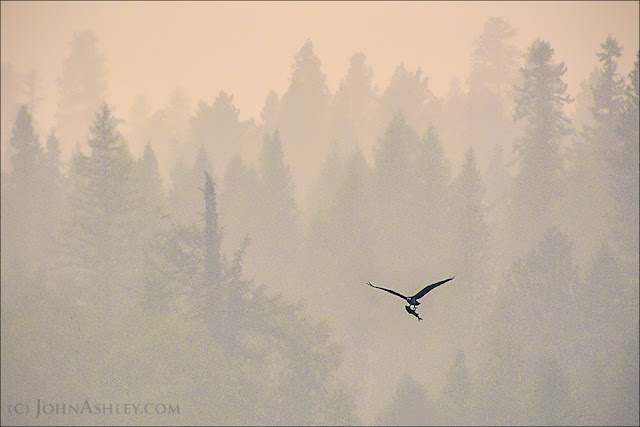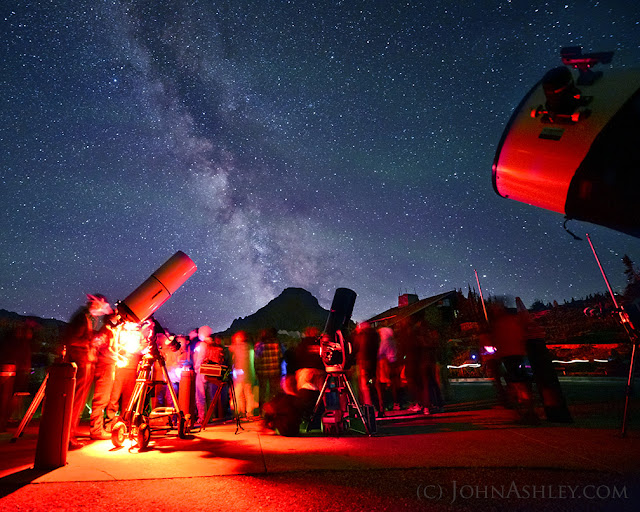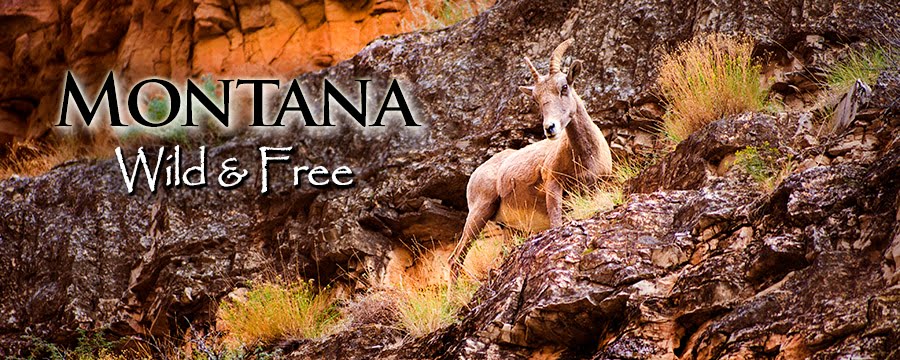Friday, October 30, 2015
Tuesday, September 29, 2015
Harvest Moon Lunar Eclipse
 |
| Lunar eclipse rises above Glacier's Garden Wall, photographed at a 4-minute interval |
In this interval photograph, I photographed the moon every 4-minutes after it rose above the Garden Wall. The moon moves out of Earth's shadow while clipping Mount Oberlin, then returns to a fully sunlit moon shining above Clements Mountain. In the bottom left, you can see horizontal headlights (white) and taillights (red) of cars driving along the Going-to-the-Sun Road. Also in the foreground, orange cottonwood leaves were lit by a passing car in the valley floor about one-quarter mile away from my camera location.
Wednesday, August 26, 2015
Dog Days Bearing Down
Hard to bear our dog days during August -- especially when you're wearing a thick fur coat. But this youngster beat the heat today by relaxing in the cool waters of a Glacier Park beaver pond.
Monday, August 24, 2015
Sunspot Revisited
 |
| Sunspot AR2403 visible at sunset today through smoke and clouds |
Smokey Bear Lied
 |
| An osprey flies away with fish in tow through smokey, western Montana skies. |
Thursday, August 20, 2015
Spotting Sunspots
 |
| Sunspot AR 2403 visible through a smokey sunset on August 20th |
We have a lovely sunspot (AR 2403) spinning nicely into view over the next several days. And all of the smoke over western Montana is actually making it a lot easier to see this dark region on a dimmed-down sun.
Our roiling sun is stratified into several layers. The photosphere is a thin, outer layer that's about 60 miles (100 km) thick where the sun's energy is released as light, and this is where sunspots occur. Sunspots are actually quite bright, but they appear dark compared to the boiling plasma surrounding them. At 3,800K degrees, sunspots are about 1,500K degrees cooler than the brighter plasma. Sunspots include two groups or clusters. One group has a negative charge while the other group is positive. The darkest part of a spot is where the magnetic field is strongest.
These spots are caused by interactions in the sun's magnetic field, but we still don't fully understand the process. Smaller spots last a few days while the larger ones can persist for months and many revolutions around the sun. Because the sun isn't solid, different regions rotate at different speeds. A point on the sun's equator makes a complete revolution in about 24 Earth days, while the polar regions spin slower and take about 30 Earth days. Sunspots are concentrated in two bands on either side of the solar equator, so a big group might circle the sun in 25 days or so.
Sunspots come and go, but their numbers aren't random. They wax and wane in 11-year cycles known as solar minimum and maximum. The most recent solar minimum occurred in 2008, so we should be slowly building towards a solar maximum in 2019. Maybe by then all of this smoke will have cleared.
Wednesday, August 19, 2015
A Wildfire Update
 |
| Our reddish moon tonight was caused by smoke particles scattering away the blue wavelengths. |
With a month or so to go in our fire season, Montana is a little bit over the 10-year average for number of fires (1,861 to 1,648). But acreage-wise, we've only burned about one-third of our 10-year average (118,154 to 338,252), so far.
What happens next? With all due respect to the "fighters" and the millions of dollars spent and the prayers sent skyward, it depends entirely on the weather. An early snow and our fire season ends. A late summer and we're smoked.
Again.
One hundred and five years ago today, a cold front swept across the Northern Rockies. Hurricane-force winds fanned 1,736 small fires into one or two conflagrations that burned an estimated 3,107,819 acres in Montana and Northern Idaho in just two days -- the Great Fire of 1910. That one burned 265 times the acreage of our current year-to-date total in Montana. Two hundred and sixty-five times more. And that's the year when we became obsessed with pretending to control wildfires.
Pray all you want, spend all you can, and risk thousands of young lives. But the forests will still burn. Always have. It's frustrating, I know, because we like to thump our chest and think that we're above nature. We're not. Fire season in Montana is an annual reminder of the lesson we never seem to learn.
Tuesday, August 18, 2015
Flying Squirrel Meet-up
Met a flying squirrel late last night while helping Glacier Park biologists capture/measure/release native bats. He vaulted silently from a tree somewhere in the midnight dark and made a surprise landing in one of our mist nets. We were pleased to make his acquaintance; he felt otherwise. He immediately anchored his teeth on one gloved finger while three of us untangled him by the dim light of our headlamps. He didn't want to let go even after we freed him from the net, clinging to an empty glove that was way too big to fit his tiny hands. He eventually relinquished the prize, and we place him on a nearby cottonwood trunk. He shimmied up and disappeared back into a nighttime ecosystem that our eyes can only wonder about.
 Our northern flying squirrel (Glaucomys sabrinus) is built to work the night shift. Our daytime red squirrel (Tamiasciurus hudsonicus) returns to its nest before dusk because it can't see in dim light. But even though the flying squirrel is considerably smaller than its daytime cousin, its eyes are twice as large to gather more light at night. While red squirrel eyes have mostly color-detecting cone cells, flying squirrel eyes have mostly dim light-detecting rod cells.
Our northern flying squirrel (Glaucomys sabrinus) is built to work the night shift. Our daytime red squirrel (Tamiasciurus hudsonicus) returns to its nest before dusk because it can't see in dim light. But even though the flying squirrel is considerably smaller than its daytime cousin, its eyes are twice as large to gather more light at night. While red squirrel eyes have mostly color-detecting cone cells, flying squirrel eyes have mostly dim light-detecting rod cells.
Like other nocturnal animals, flying squirrels also have "mirror" behind their retinas that reflects dim light back to the rod cells, effectively amplifying their night vision. This tapetum layaccounts for some of the animal eyes that you and I see when we shine a flashlight into the dark -- our light reflects off the animal's tapetum bright enough for our eyes to see.
 Our northern flying squirrel (Glaucomys sabrinus) is built to work the night shift. Our daytime red squirrel (Tamiasciurus hudsonicus) returns to its nest before dusk because it can't see in dim light. But even though the flying squirrel is considerably smaller than its daytime cousin, its eyes are twice as large to gather more light at night. While red squirrel eyes have mostly color-detecting cone cells, flying squirrel eyes have mostly dim light-detecting rod cells.
Our northern flying squirrel (Glaucomys sabrinus) is built to work the night shift. Our daytime red squirrel (Tamiasciurus hudsonicus) returns to its nest before dusk because it can't see in dim light. But even though the flying squirrel is considerably smaller than its daytime cousin, its eyes are twice as large to gather more light at night. While red squirrel eyes have mostly color-detecting cone cells, flying squirrel eyes have mostly dim light-detecting rod cells.Like other nocturnal animals, flying squirrels also have "mirror" behind their retinas that reflects dim light back to the rod cells, effectively amplifying their night vision. This tapetum layaccounts for some of the animal eyes that you and I see when we shine a flashlight into the dark -- our light reflects off the animal's tapetum bright enough for our eyes to see.
Thursday, August 13, 2015
Perseid Meteor Shower
Early this morning we entered the main dust trail that sparks the annual Perseid meteor shower. Coyotes started singing at the stroke of midnight, but meteor numbers didn't start ramping up until the barred owl started calling at around 2 a.m. This is a composite of 17 meteors that fell above Mount Saint Nicholas in Glacier National Park, Montana, between 3 a.m. and 4 a.m. We'll still be on the dusty road again tonight, but I will be sound asleep!
Saturday, August 8, 2015
Glacier Park Star Party
 |
| Glacier National Park star party at Logan Pass, August 2015 |




